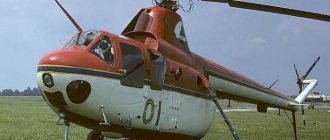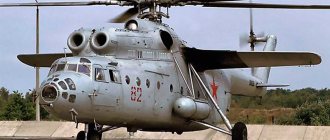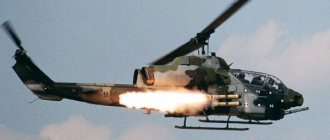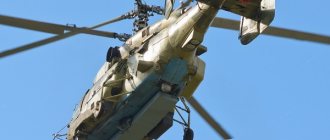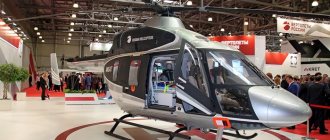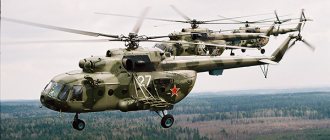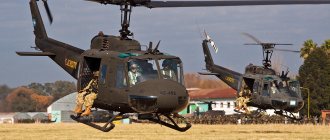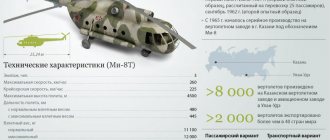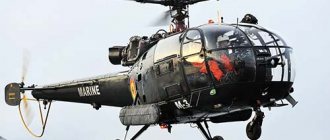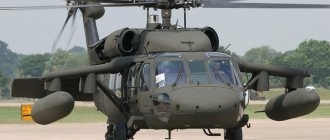Expert about the Ka-90 project: the helicopter will fly using propellers and a jet engine
Columnist for the Popular Mechanics publication Roman Fishman said that the project of the Russian ultra-fast Ka-90 helicopter looks better in terms of technical characteristics than the American tiltrotor Sikorsky S-97 Raider.
According to Fishman, the American reconnaissance helicopter is a sought-after piece of equipment, but it is extremely expensive and unreliable. Recent tests, which ended in a hard landing, only confirmed this. Such problems arise because the project is too “raw”. Russia approaches this issue more competently. And the development of the Ka-90 helicopter-plane is a clear confirmation of this.
For the first time, the Russian-developed concept was presented during the international exhibition “HeliRussia-2008”. Even then, it aroused increased interest among the public and international experts. The promising project is a kind of symbiosis of a helicopter and an airplane. Representatives of the plant noted that the Ka-90 is a completely unique concept, since it uses a fundamentally new innovative technical design.
Source: wikipedia.org/Vitaly V. Kuzmin/CC BY-SA 4.0
A special feature of this development is the fact that it uses both conventional propellers, traditional for helicopters, and a jet engine used in aviation. Moreover, heated debates broke out about the power plant. It still remains a mystery what type of engine will be installed during development. We are talking about either a gas turbine engine (GTE) or a turbofan unit (TRF). Experts are inclined towards the second option, which will allow power take-off for the main rotor during takeoff.
Illustration source: wikipedia.org/Public domain
Specialists from Kamov OJSC, who are developing the Ka-90, reported that the helicopter will be lifted from the ground using propellers. When the speed reaches 400 km/h, the jet engine will turn on, which accelerates the aircraft model to 800 km/h. In this position, the propellers fold, allowing the helicopter to be controlled by jet propulsion. When landing, the propellers open again and the helicopter lands normally. The correspondent complains that at the moment it is not possible to look at the development, since there is not a single video. But according to the stated data, it is clear that the Russian development will be superior to the American one. After all, it reaches a speed of 450 km/h and does not have a unique operating principle.
According to the design bureau’s plans, the development of the Ka-90 can begin testing before 2022, and from 2022 the ultra-fast, jet helicopter will be available to the army.
V-7 - Mil OKB's most experienced jet helicopter
In the middle of the 50s, when the design of the Mi-6 helicopter was largely completed, the designers of the M.L. Mil Design Bureau began to search for promising ways for the upcoming increase in the carrying capacity of rotary-wing aircraft. One of the higher priority areas in those years was the creation of helicopters with a jet drive main rotor, i.e. with a drive in which the torque of the screw is created by the reaction force of the gases.
Jet helicopter B-7 - video
Gases flowing from jet engines or jet nozzles installed at the ends of the blades. The abandonment of the mechanical gearbox should not only simplify and lighten the design of the helicopter, but also significantly affect its weight efficiency. In addition, with all this, there was no reactive torque of the main rotor, and therefore, there was no need for energy-intensive and massive means of counteracting it, which also simplified the assembly of the helicopter. Of all types of jet drives, the drive by means of turbojet engines seemed to be more economical. The design bureau was developing a project for such a super-heavy helicopter crane (one of the B-16 projects) with a main rotor with a diameter of about 60 m. At the end of each blade, it was planned to install 2 turbojet engines with reverse rotation of turbines and a thrust of 1750 kg each. But previously M.L. Mil wanted to build a small, experimental 4-seater helicopter, on which he was to test the jet drive of the main rotor and solve a number of problems specific to such a design. He managed to intrigue with his own idea, first the representatives of the Civil Air Fleet, and then the military, and on December 20, 1956. A government decree was issued on the development of an experimental B-7 helicopter with a jet-powered main rotor.
The design and construction of the rotorcraft, the smallest and lightest ever made by the Mil Design Bureau, progressed very rapidly. In December 1957 The detailed design was basically completed, and the most experienced creation of plant No. 329 immediately laid out a series of 5 machines. A.V. Kochkin was appointed lead designer for the B-7, and then G.G. Lazarev. The design of the helicopter was very conventional. The base was an all-metal teardrop-shaped fuselage of semi-monocoque riveted construction. In the upper part of the load-bearing frames, a cast plate was mounted on bolts. A gearbox, consisting of a main rotor shaft and unit drives, was attached to the flange of the plate. A hub with blades and a swashplate were installed on the axis of the main rotor shaft. A bracket with control rockers and hydraulic boosters was attached to the front end of the plate. There were three doors along the edges of the fuselage. In addition to the pilot, the cabin could accommodate three more passengers or a stretcher with a patient and an accompanying medical worker. The fuel tank was located under the floor. The pump directed the fuel to the fuel regulator, from which it entered the main rotor shaft manifold and from there, under the influence of centrifugal force, to the turbojet engines located at the ends of the two-blade main rotor.
The rectangular blades had a metal spar, a wood frame and plywood sheathing. They were attached to the bushing by means of axial and general horizontal hinges. Two fuel supply tubes were installed in the toes of the blade ribs. The wiring ran inside the spar. A current collector for power plant devices was mounted on top of the end of the main rotor shaft. When developing the track control system, at first they planned to limit themselves to the tail unit installed in the inductive flow, but the comprehensive studies of models in the wind tunnel that accompanied the development of the B-7 showed the need to retain the control rotor. It was installed at the rear of the fuselage on a short tubular truss. Thus, it was not possible to avoid installing the box on the helicopter. On the B-7, the designers of the M.L. Mil Design Bureau used a skid chassis for the first time.
Hydraulic shock absorbers mounted on the rear cross tubes served to prevent ground resonance. The B-7 helicopter was equipped with a lightweight set of flight instrumentation equipment, and a military version with a weapon system was envisaged.
The successful implementation of the idea of a helicopter with a jet drive main rotor depended first on the creation of fairly light and compact engines capable of working firmly in the field of centrifugal forces under enormous overloads, as well as fuel supply systems and their control. Of the many managers of aircraft engine design bureaus involved in solving this problem, only chief designer A.G. Ivchenko took up the design of special turbojet engines. The AI-7 engine with a thrust of 70 kgf, developed in his OKB-478, was a simple turbojet engine with a centrifugal compressor and a single-stage turbine. In order to balance the gyroscopic moments, the engine was made with 3 flywheels that rotated in the direction opposite to the turbine. This decision was simple, but, as subsequent actions showed, wrong. The AI-7 engines were received by plant No. 329 exclusively in December 1959, the helicopter itself was assembled a long time earlier. Immediately after the first launch of the turbojet engine, problems arose: the engine did not reach operating speeds and did not develop this thrust due to the huge power take-off for rotation of the flywheels. That's why they had to be removed from the engines. To cool the overheated oil system, the engineers of the M.L. Mil Design Bureau designed a unique tubular oil cooler located around the engine air absorber. Now AI-7 was developing the specified thrust, but the load-bearing system began to take all the loads from the gyroscopic moment.
Helicopter B-7 - photo from the Russian Air Force Museum in Monino
The implementation of the concept of a helicopter with a jet-powered main rotor turned out to be much more difficult than expected. The development of the V-7 and its power plant took a long time. CIAM specialists were brought in to improve the AI-7 engines. It took a couple of years to solve the problem of ensuring the operation of engines in the field of centrifugal forces, and only on February 19, 1962. The first attempt was made to lift a B-7 into the air on a leash. But the helicopter failed to get off the ground. Under the influence of the gyroscopic moment of the engines, the main rotor blades twisted to a negative angle, the skin of the blades was covered with corrugations, which created enormous resistance to rotation, reinforced by the uncapped engines. In addition, the power of the collective pitch hydraulic booster turned out to be insufficient to overcome the loads in the control system. The vibrations of the helicopter were great. After which the test engines were sent for rework to the A.G. Ivchenko Design Bureau, the blades were repaired, the hydraulic booster of the collective pitch control system was changed to a more powerful one, and hoods were designed for the engines.
Cabin of the B-7 helicopter
In April 1965 Tethered tests of the B-7 resumed, but during the first launch one of the engines jammed. I had to return it to the manufacturer again. Finally, on September 20, a stable hover was achieved twice. The tests were carried out by mechanic V.A. Kolosov. Hovering occurred with a decrease in the rotor speed, because in this case the engines produced the least torque and the blades did not twist or warp. According to the 1965 program it was planned to estimate the actual power at different operating speeds of the main rotor, but this year was the last in the history of the development of the B-7. November 11, 1965 During tests at the highest rotor speeds and the take-off mode of the engines, there was almost simultaneous destruction of both engines. As it turned out later, the take-off mode of the AI-7 engine was critical. The engine's turbochargers went into resonant vibrations and, breaking the housing, “flew away” along with the rear parts of the engines. The helicopter smoothly sank to the ground without damage.
Instrument panel of a B-7 helicopter
The designers were obliged to recognize the subsequent development of the AI-7 as unpromising. They pinned their hopes on the new MD-3 turbojet engine developed at CIAM, the gyroscopic moment of which was balanced by the reverse rotation of the compressor and turbine. And this engine needed long-term fine-tuning, like, in general, many other elements of the helicopter. Fuel consumption with a jet-driven main rotor scheme turned out to be significantly greater than originally expected. The noise level was also high. Then M.L. Mil concludes that it is optimal to increase the lifting capacity of helicopters by using multi-rotor designs with a manual gearbox. Development of the B-7 was stopped.
AI-7 engine of the B-7 helicopter
Tactical and technical properties of the B-7 helicopter
| Crew | 1 |
| Passenger capacity | 3 |
| Dimensions | Length: 6.23 m Main rotor diameter: 11.60 m Height: 2.91 m |
| Empty mass | 730 kg |
| Normal take-off weight | 835 kg |
| Maximum take-off weight | 1050 kg |
| Power point | 2 × AI-7 turbojet engines |
| Highest speed | 240 km/h |
| Cruising speed | 210 km/h |
| Practical range | 510 km |
| Ferry range | 1000 km |
| Service ceiling | 4500 m |
The latest multi-purpose helicopter
The Russian Ka-58 rotorcraft continues the traditions of its famous predecessors, the Ka-50 (“Black Shark”) and the later Ka-52 (“Alligator”).
In terms of its characteristics, the device is not inferior to the American Apache attack helicopter. And in some respects it even surpasses. “Black Ghost”, like all previous Kamov Design Bureau helicopters, has a coaxial design. Its essence lies in the absence of a rear propeller and the presence of two front ones, rotating in opposite directions. Due to this solution, the reactive moments that arise in this case are suppressed. An important advantage of this aircraft is its partial invisibility to radar. The Ka-58 “Black Ghost” stealth helicopter is manufactured using stealth technology.
Armed and dangerous
The helicopter has a menacing appearance. The body consists of angular elements. High speed allows the helicopter to suddenly appear and disappear just as quickly. The composite materials used in manufacturing have significantly improved the flight and technical characteristics of the helicopter. The cockpit and vital components are securely covered with armored sheets.
| Main characteristics | |
| Vertical ascent speed | 8 m/s |
| Maximum flight altitude | up to 3600 m |
| Maximum cruising speed | 350 km/h |
| Number of anti-tank guided missiles | 8 |
| Number of unguided aircraft missiles (UAR) | 40 |
| Side cannon ammunition | 500 shells |
With such a weapon on board, the characteristics of the “Black Ghost” are at the level of fantasy; the helicopter is capable of overtaking and destroying the enemy on the plain, in mountainous areas and on water.
